Hickory shad invade the Tar River in March
By March, the hickory shad run is in full swing in Eastern NC’s rivers.
This includes the Tar River, and anglers flock here this time each year to cast small lures on ultralight rods and reels for some of the most fun an angler can have in freshwater.
These shad, many of which migrate from the saltwater areas off of Nova Scotia, are on their yearly spawning migrations. Their run is fairly predictable, with the first showings occurring sometimes as early as mid-January, other times mid-February. Either way, by this month, it’s on like gangbusters.
This is when Chris Douglas of Carolina ALL OUT joins up with Capt. Richard Andrews of Tar-Pam Guide Service and Capt. Scooter Lilley of CWW Inshore Charters for a day of fun on the river.
“Usually when we get together with these guys, it’s to go after something like speckled trout. But shad fishing this time of year is an Eastern North Carolina tradition, and Richard and Scooter have been doing it forever,” said Douglas.
This is some of the most basic fishing, and that is a big part of the fun.
“Just a slow, steady retrieve is all you want. You don’t want anything fancy. You don’t even want to jig it when targeting the hickories,” said Andrews.
The gear is just as simple as the technique. Ultralight rods paired with spinning reels in the 500- to 1000-size range are perfect, allowing for easy casting of light jigs. And the size of the gear also allows anglers to hook and play these fish without overpowering them. So every shad feels like a much bigger fish. And that’s part of the reason these fish are often called the “poor man’s tarpon.” Another reason is for their acrobatic style of fighting, which often sees them go airborne after they’re hooked.
Drift or anchor
Andrews said finding the shad is pretty simple. He just drops his trolling motor and keeps his boat parallel to shore. Then they cast 1/16- to 1/8-ounce jigs with curly-tail bodies toward the bank. If they get on a particularly hot bite, he’ll anchor the boat to stay put.
“You can either anchor in a spot or you can drift. And sometimes, if you’re anchored and the fishing’s not as hot as you need it to be, you can pull your anchor up and drift-fish down the river. I do that a lot,” he said.
Finding an area with a really hot bite is the goal, he said, but sometimes you have to drift first to find such a spot.
Whether drifting or anchored, Andrews suggests keeping the bow of the boat pointed upcurrent. This helps keep the boat as straight and parallel to the bank as possible, allowing anglers in the front, the middle and the back of the boat to all have an easy time casting without fear of hooking each other’s lines.
When it comes to hooking up with a shad, Andrews (252-945-9715) cautions anglers about setting the hook too hard.
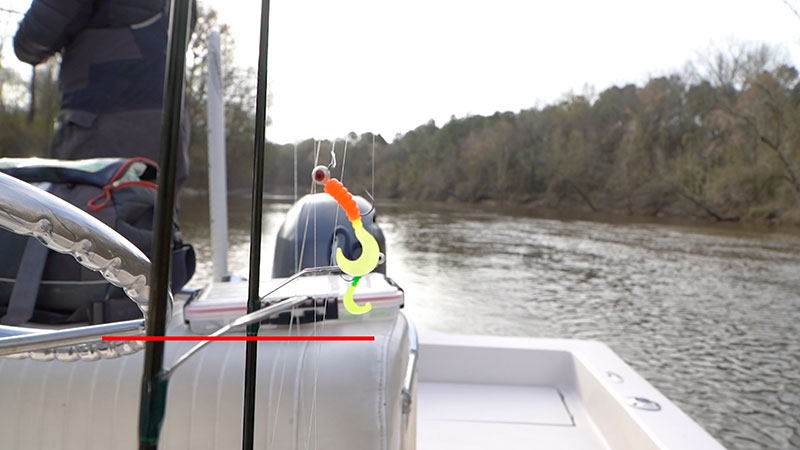
“What I do, and what I tell my clients to do, is not to set the hook. Just kind of reel right through the hookset, and when you get the fish on, then you can bend the rod,” he said. “That tends to work better. If you get too quick on the hookset, a lot of times you’ll miss the bite.”
Every one of these fish, said Douglas, could tell some tales if only they could talk.
“These fish have a story to tell. These fish have been a long way to get to here, and done it numerous times more than likely,” he said. “They’ve got to go to the ocean to live. They go north up to Canada, and here they are on our rivers. It’s a very cool fish, and you can catch these in the spring on several rivers in Eastern North Carolina.”
Rig it up
Andrews employs a double-rig setup when shad fishing. With a 3-foot section of 15-pound fluorocarbon line, he doubles about 8 inches of the line and ties a loop knot. This leaves him with a short section of line for one lure, and a long section of line for the second lure. He ties the main line from his reel onto the loop knot to complete the rig.
He uses a variety of colors for the lures, but usually likes to have chartreuse somewhere in the mix. Andrews said it’s also not uncommon to mix things up a bit by tying a small spoon onto the longer section of line and a curly tail grub onto a jighead on the shorter section.
“Tying a 1/8-ounce jig on the short section and a Nungesser spoon on the longer one, this is your basic hickory shad rig. The jig runs in the front, giving you a little bit of weight. Sometimes you’ll replace the spoon with another 1/8-ounce jig, especially when the fish are in a little bit deeper water. This gives you 1/4 ounce of total weight.
“And on some days, you’ll find most of your bites are coming on the spoon. On other days, it’s on the jig. So you can start off with that, then mix it up as you see what the fish are biting most,” he said.
Water levels
Some years, the river’s water level is higher than normal. When this happens, Andrews said anglers often need to cast where water usually isn’t.
“If the water is high, then sometimes where we normally would fish in shallow water, it’s deeper. So then we’ve got to cast a lot closer to the bank. That’s just a part of it. You’ve got to make adjustments and figure it out,” he said.
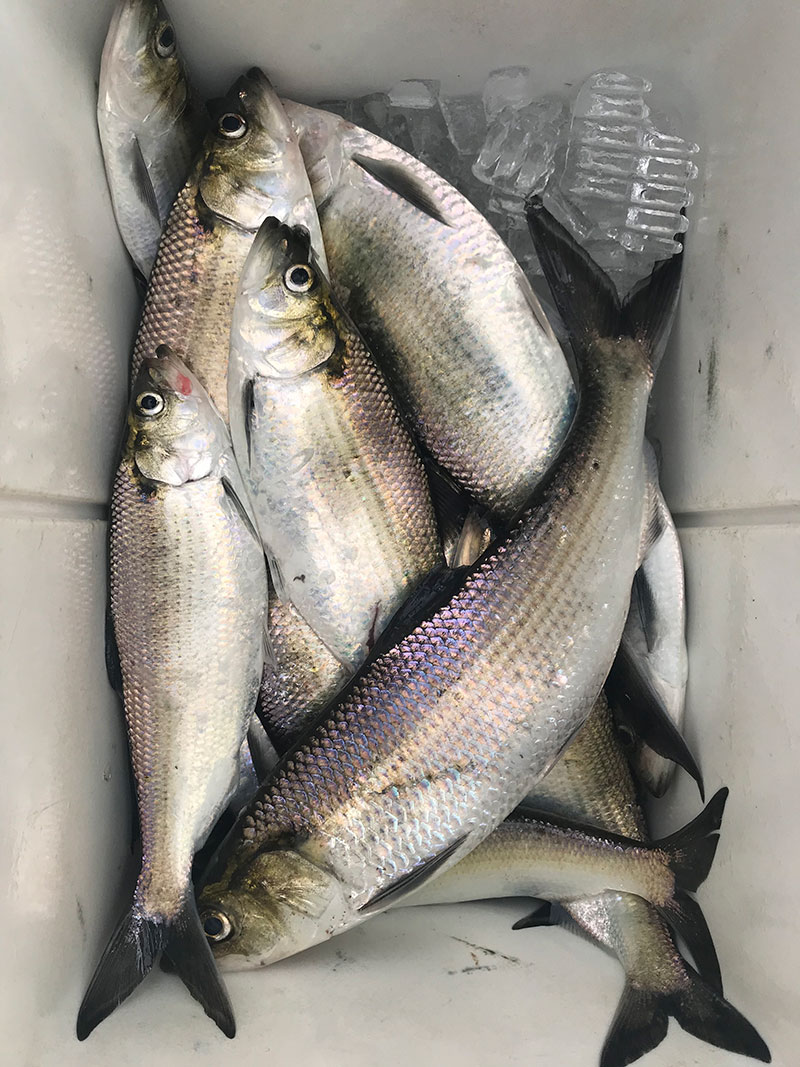
Andrews likes to keep a few fish to eat, but he said anglers should be fairly gentle on the fish you’re going to release. He prefers to keep males and maybe one or two females, called “roe shad,” which make delicacies in their own right.
“It’s important to handle these fish properly, and try to minimize the amount of scales you knock off. You want to handle them very gently. You can lip them and support their belly, but much more than that is too much. These fish have swam a long way to get here to spawn, and it’s our duty to take care of them,” he said.
Andrews stressed that even anglers without a boat can catch plenty of shad this time of year. And this is true even if they only have access to tributaries of Eastern NC’s main rivers.
“You don’t have to have a boat to catch these fish. Some of the best fishing for them can be done from the bank, even in tributaries way up the Tar River,” he said.
For bank-bound anglers, the gear is still the same. The casting is slightly different, simply because instead of casting toward the bank, you’re standing on it. So casting toward the middle of the river – or to the opposite bank if you can reach it – is your best bet. The same steady retrieve used from the boat will trigger strikes here.
Hickory shad shore lunch
For Douglas, Andrews and Lilley, a good day of shad fishing isn’t complete without a shore lunch. They carry a portable and very capable setup from Carolina Cooker, which packs easily into one milk crate, and gets the job done with gusto once it’s time to fry some fish. It includes a small propane tank, a burner and a cast iron skillet.
“This kind of fishing is a long-held North Carolina tradition, so what better way to make a shore lunch than with this setup from a North Carolina company,” said Douglas.
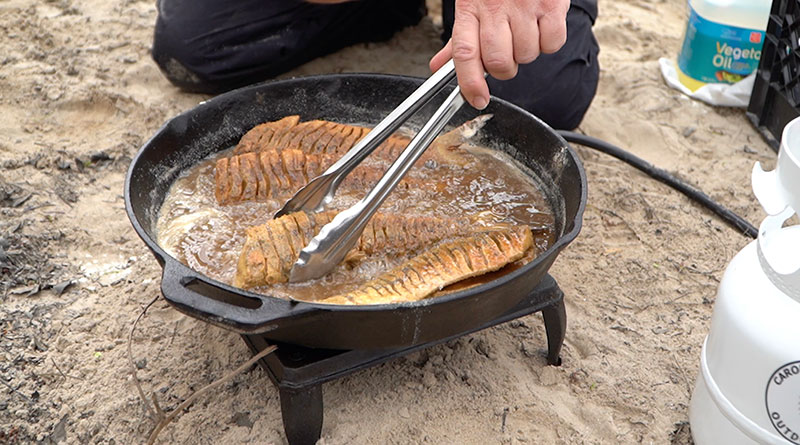
When it comes to cooking shad, the preferred method is known as “hard cooking” or “cremating,” which means you cook them until the bones disintegrate, allowing you to eat the fish without the trouble of deboning them.
Preparing them is just a matter of heading, scaling and gutting them, then scoring the sides of the body the entire length of the fish. This helps them cook faster and aids the grease in cooking straight through the bones.
Douglas heats vegetable oil in the skillet until it’s about 380 degrees, then lays out the fish, which he coats with a thin layer of fish breader, turning several times as they cook. He cooks them thoroughly, to the point that some may consider them burnt. That’s all a part of “hard cooking” them.
The roe from females are removed, cleaned, lightly breaded and fried in the same manner, although not quite as long.
The finished product?
“It’s a true delicacy,” said Douglas.

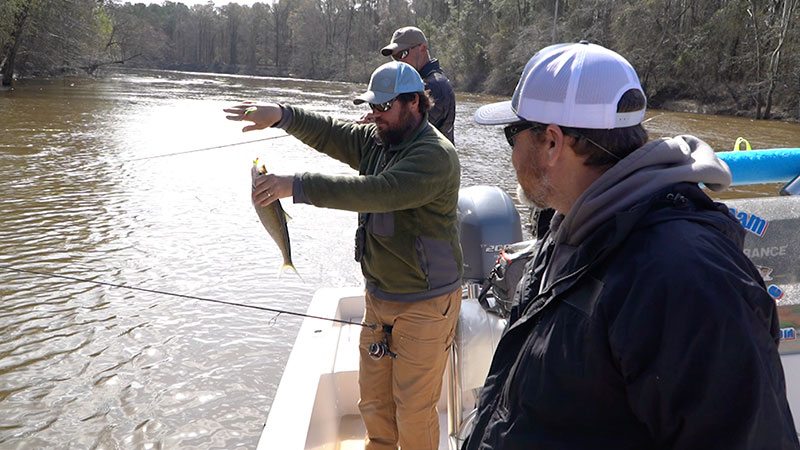

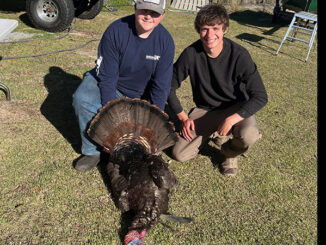
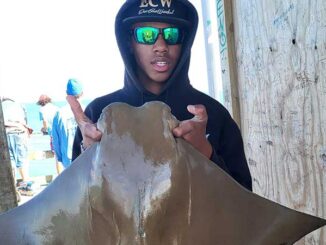

Be the first to comment